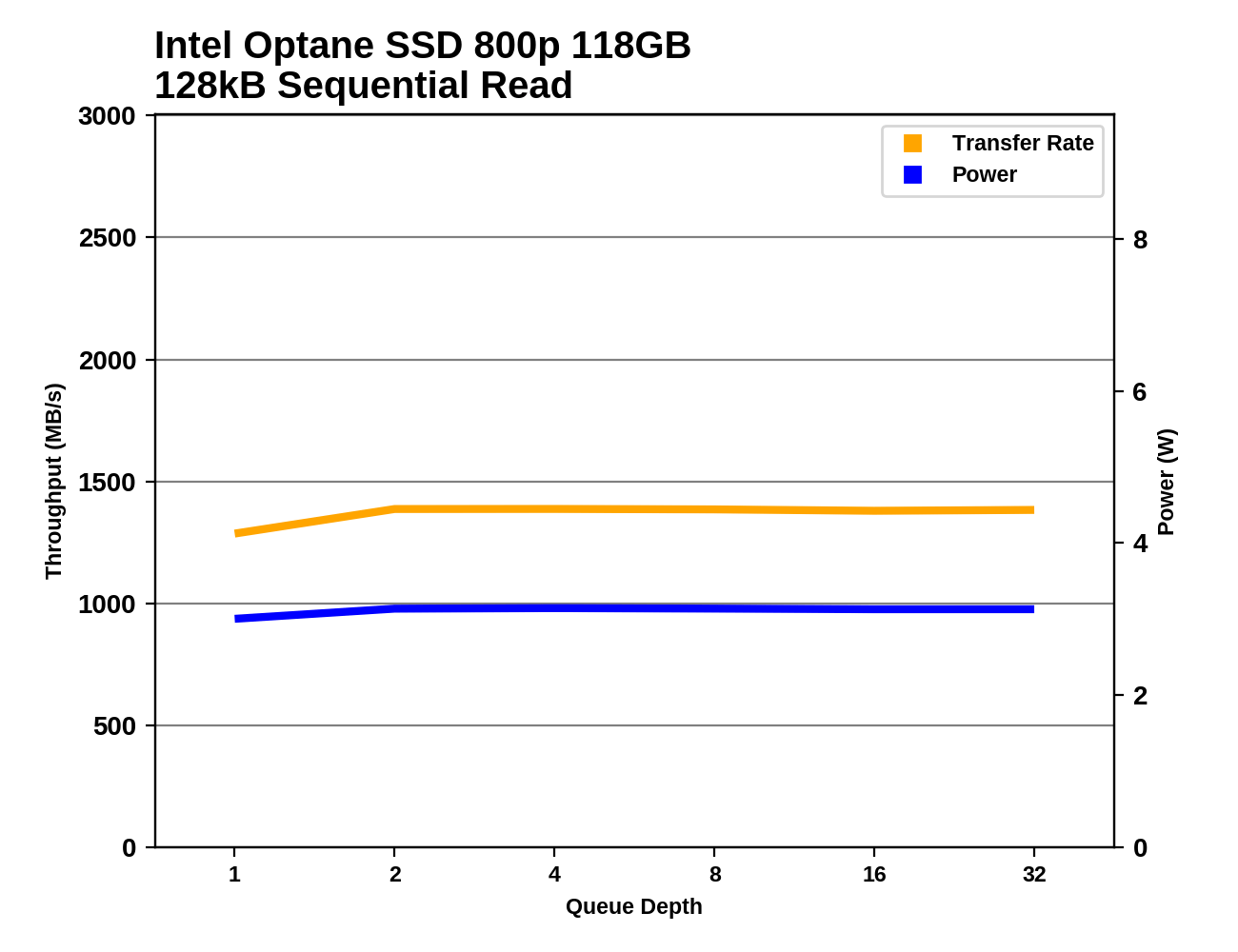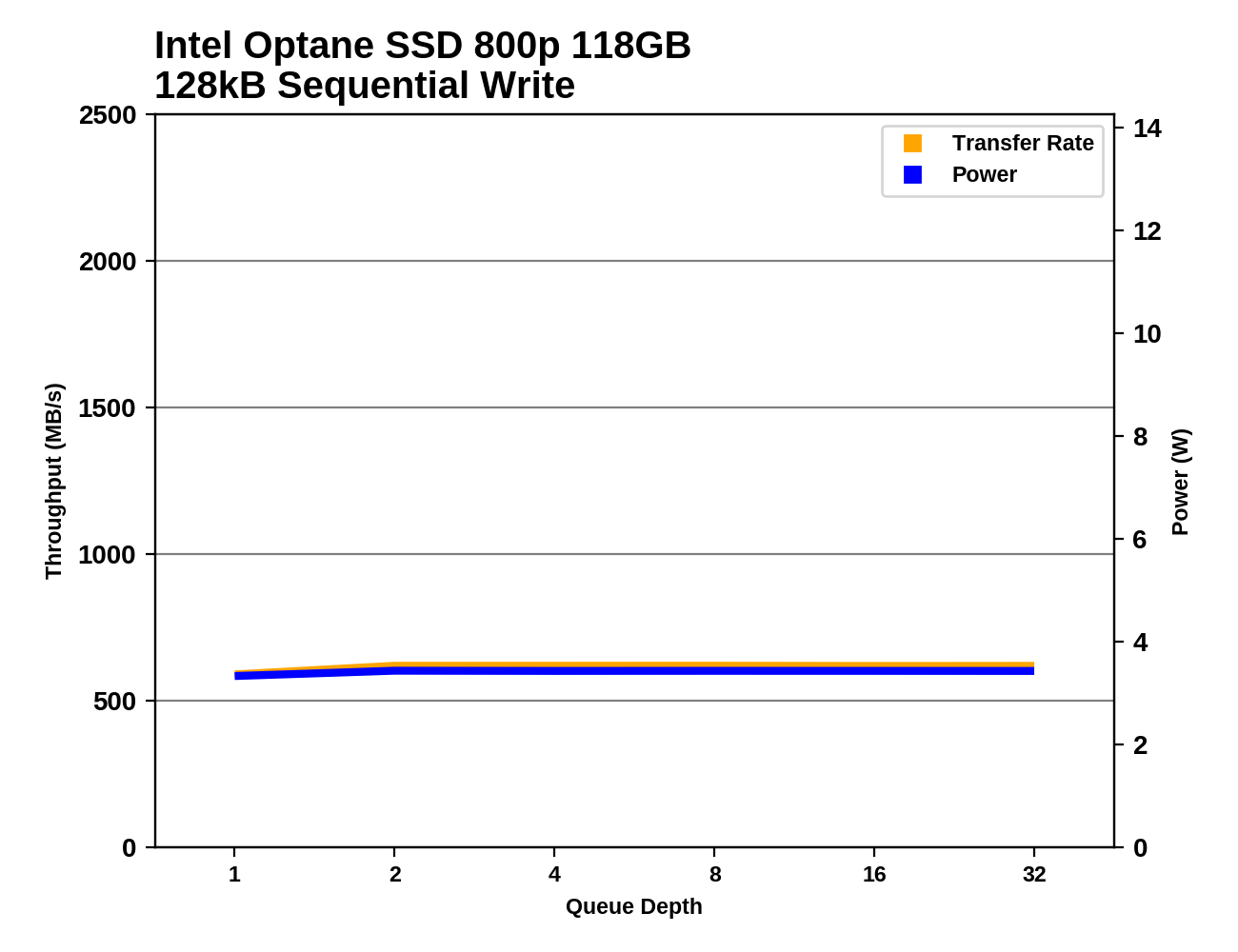The Intel Optane SSD 800p (58GB & 118GB) Review: Almost The Right Size
by Billy Tallis on March 8, 2018 5:15 PM ESTSequential Read Performance
Our first test of sequential read performance uses short bursts of 128MB, issued as 128kB operations with no queuing. The test averages performance across eight bursts for a total of 1GB of data transferred from a drive containing 16GB of data. Between each burst the drive is given enough idle time to keep the overall duty cycle at 20%.

The QD1 burst sequential read performance of the Intel Optane SSD 800p is close to their rated maximum throughput, but they are far behind the 900p and high-end Samsung drives that actually need more than two PCIe lanes.
Our test of sustained sequential reads uses queue depths from 1 to 32, with the performance and power scores computed as the average of QD1, QD2 and QD4. Each queue depth is tested for up to one minute or 32GB transferred, from a drive containing 64GB of data.

On the longer sequential read test, the Samsung NVMe SSDs fall down to the level of the Optane SSD 800p, because the flash-based SSDs are slowed down by some of the data fragmentation left over from the random write test. The Optane SSDs performed those writes as in-place modifications and thus didn't incur any fragmentation. This leaves the Samsung 960 PRO 2TB barely faster than the 800p, while the 900p runs away with its lead.

The Optane SSD 800p has the clear lead in power efficiency, as its second-tier performance comes with far lower power consumption than the top-performing 900p.
 |
|||||||||
There are no big surprises with the queue depth scaling; the 800p's sequential reads are slightly faster at QD2 than QD1, but there's no further improvement beyond that. The 800p is easily staying within its 3.75 W rated maximum power draw.
Sequential Write Performance
Our test of sequential write burst performance is structured identically to the sequential read burst performance test save for the direction of the data transfer. Each burst writes 128MB as 128kB operations issued at QD1, for a total of 1GB of data written to a drive containing 16GB of data.

The burst sequential write speed of the Intel Optane SSD 800p is no better than the low-end flash-based NVMe SSDs. Without any write caching mechanism in the controller, the fundamental nature of 3D XPoint write speeds shows through. The 900p overcomes this by using a 7-channel controller, but that design doesn't fit within the M.2 form factor.
Our test of sustained sequential writes is structured identically to our sustained sequential read test, save for the direction of the data transfers. Queue depths range from 1 to 32 and each queue depth is tested for up to one minute or 32GB, followed by up to one minute of idle time for the drive to cool off and perform garbage collection. The test is confined to a 64GB span of the drive.

The Optane SSD 800p looks better on the sustained sequential write test, as all the TLC-based SSDs run out of SLC cache and slow down dramatically, while the Optane SSDs keep delivering the exact same performance.

Despite their very different sequential write throughput, the Optane SSD 900p and 800p end up with very similar power efficiency on this test. The Samsung NVMe drives are even more efficient, but only the premium MLC-based 960 PRO has a large lead.
 |
|||||||||
Almost all of the drives show no performance scaling with increasing queue depth, as large-block sequential writes can keep all the memory channels busy with only a little bit of buffering. The 900p needs at least two 128kB writes in flight to reach full throughput.










116 Comments
View All Comments
patrickjp93 - Saturday, March 10, 2018 - link
Until you start running databases, multi-tenant VM environments, and large swap files for map-reduce, inference drawing, etc..xenol - Monday, March 12, 2018 - link
Yeah, let me know when the average consumer uses that.keralataxi - Monday, March 26, 2018 - link
thank you for sharing this.This site is really helpful to me and i think you have to collect more details about the topic.http://keralatravelcabs.com/tempo-traveller-taxi-s...
JohnBooty - Monday, March 26, 2018 - link
Rrrrrrright. So, yes, a human wouldn't perceive... the latency improvement seen on a single IOP on Octane vs. an alternative.Bravo. That's about as insightful as pointing out that a human also wouldn't notice the difference in latency between a single operation on a 3ghz CPU vs. a 4ghz CPU. Because microseconds, amiirite?
Just for your reference: this is 2018. Unless we're traveling back to 1985 and benchmarking the floppy drive on a Commodore 64, we usually measure the performance or modern by looking at the aggregate performance of thousands or even millions of operations.
Ewitte12 - Monday, April 30, 2018 - link
When something is loading it is rarely doing 1 task. Hundreds or thousands of tasks will definitely be noticeable. You would be surprised how much goes on just loading an app...MrSpadge - Friday, March 9, 2018 - link
No, I can't remember anyone saying that. It was supposed to be an intermediate step between high NAND and DRAM.ATC9001 - Friday, March 9, 2018 - link
It very well may cost less than NAND, but no business in the world is going to sell a product that's faster for less than another one of it's products (unless it simple doesn't sell, which is surely not that case for NAND).I'm pretty excited overall...sure it's hyped up a lot, but remember the first SSDs? Took a while to figure out the controllers and such.
It's great to see the low latency...with DRAM prices the way they are *MAYBE* some enterprise customers will look to optane.
As a gamer, I'm more concerned with sequential performance and higher capacities, but for prosumers with high random workloads this might make sense.
sharath.naik - Sunday, March 11, 2018 - link
More importantly wan't xpoint supposed to have endurance many times over an SLC nand?. The spec here is not much better than an MLC let alone SLCchrnochime - Thursday, March 8, 2018 - link
And FWIW, I value endurance(write cycle) far more than speed. So if it's as fast as SLC I'm okay with that.iter - Thursday, March 8, 2018 - link
Performance means the actual media performance, that includes P/E latency and endurance. slc has great endurance, that I myself would be more than willing to pay for, alas there is no such an option as no slc products have been made the last few years.